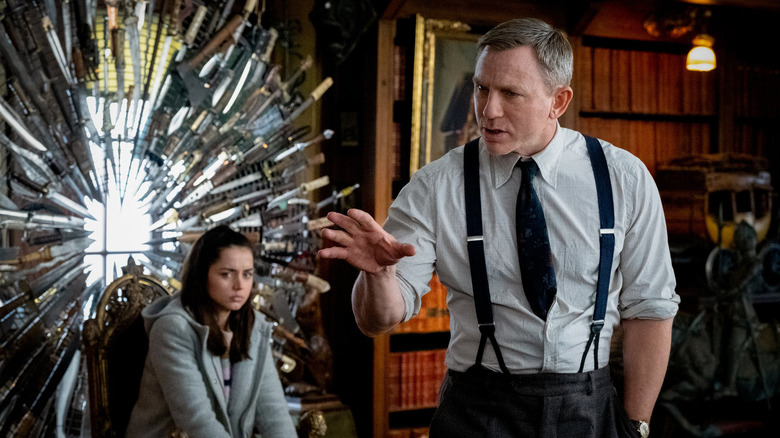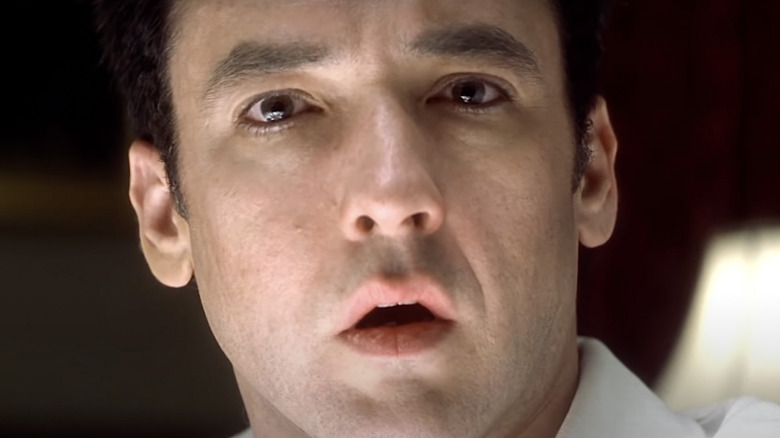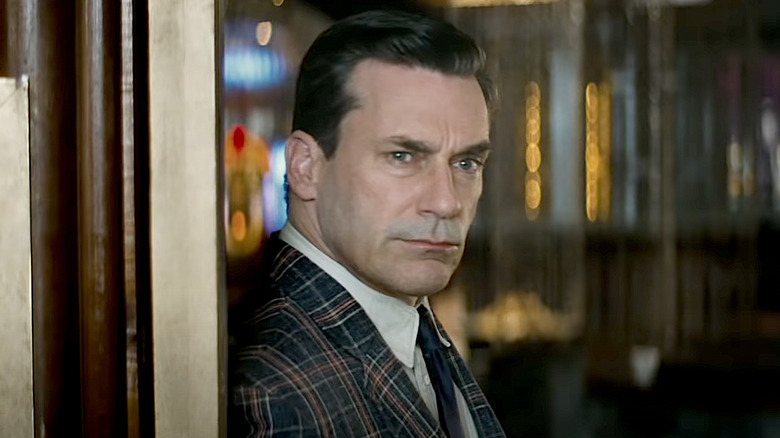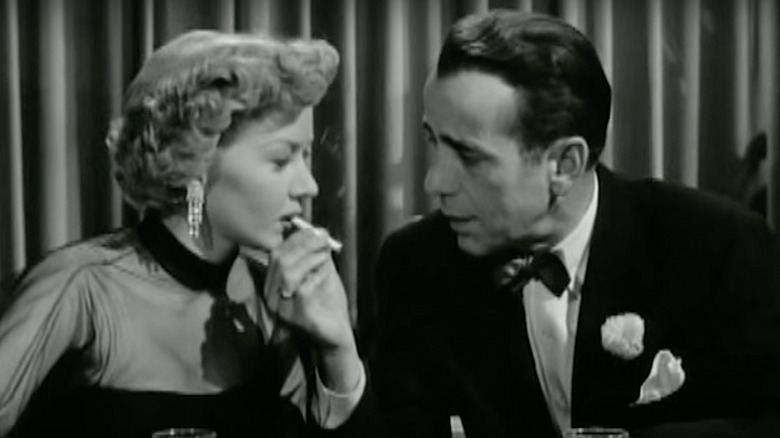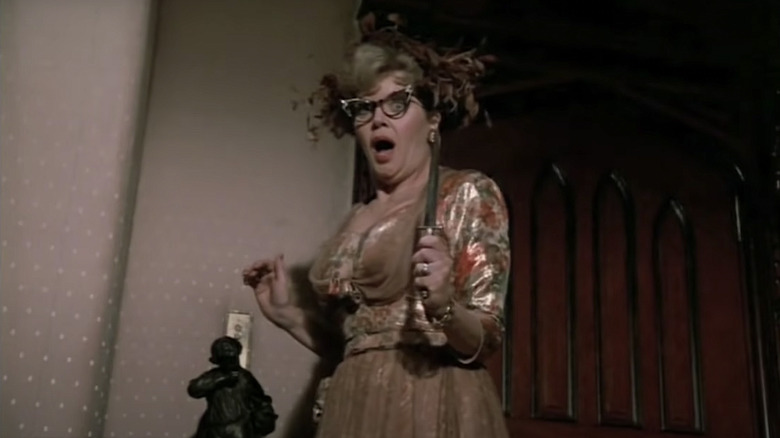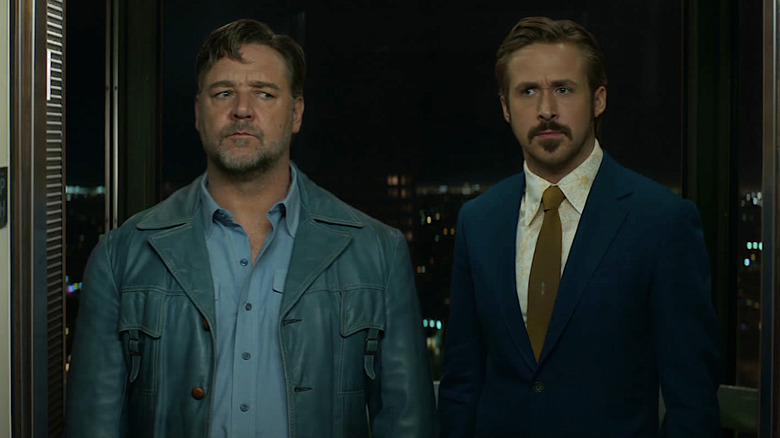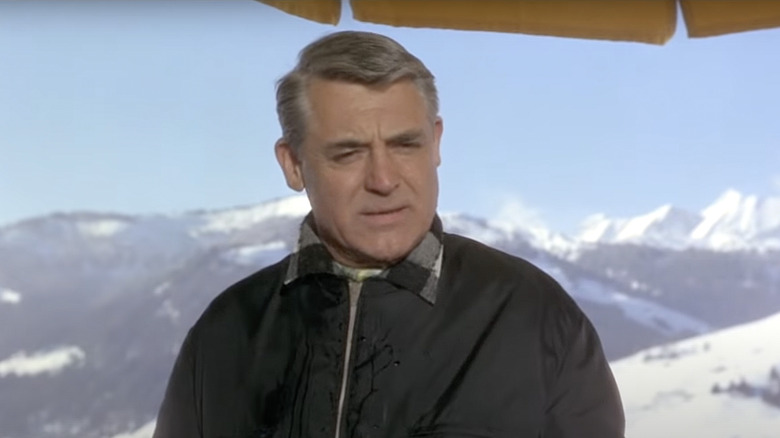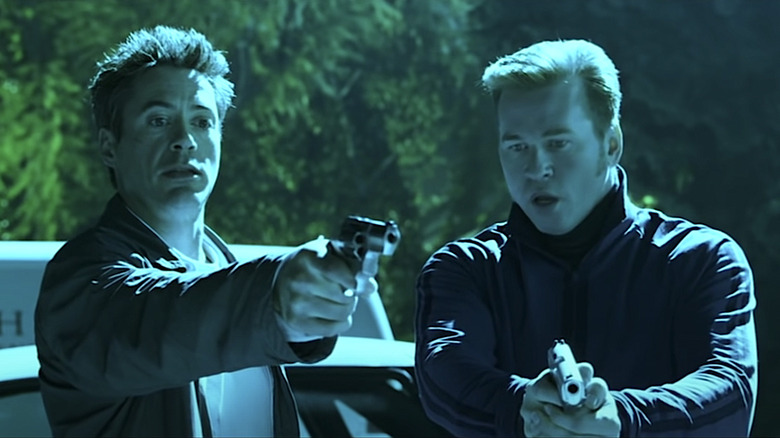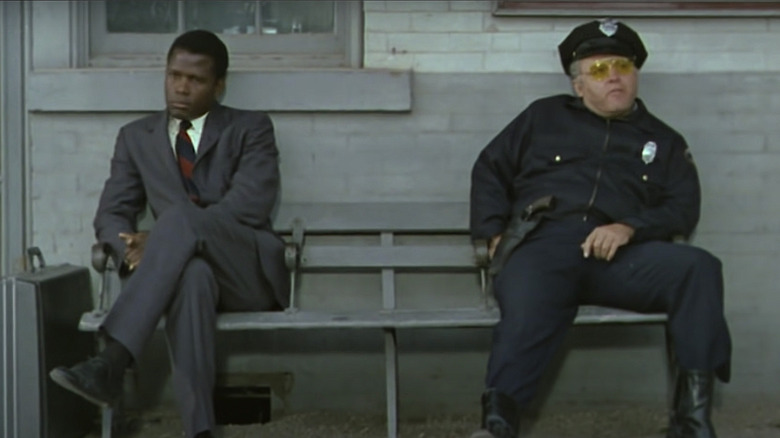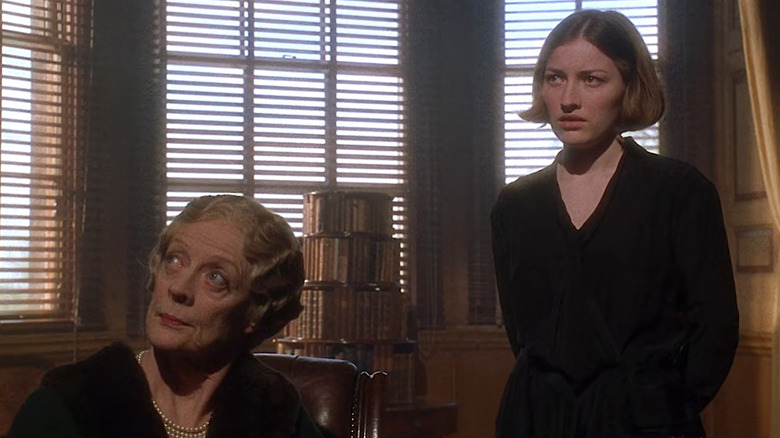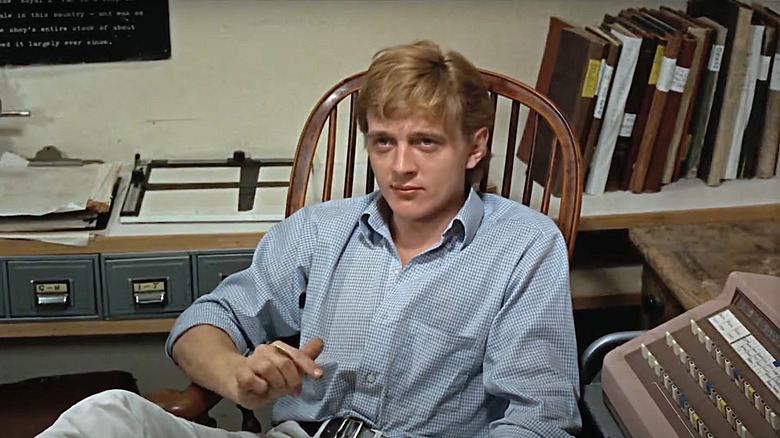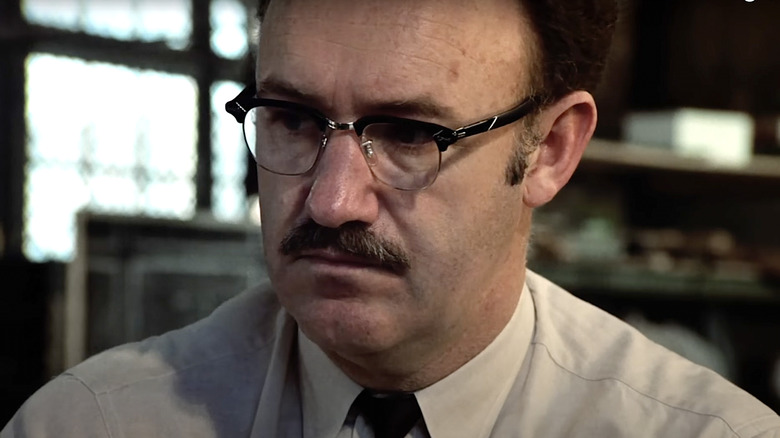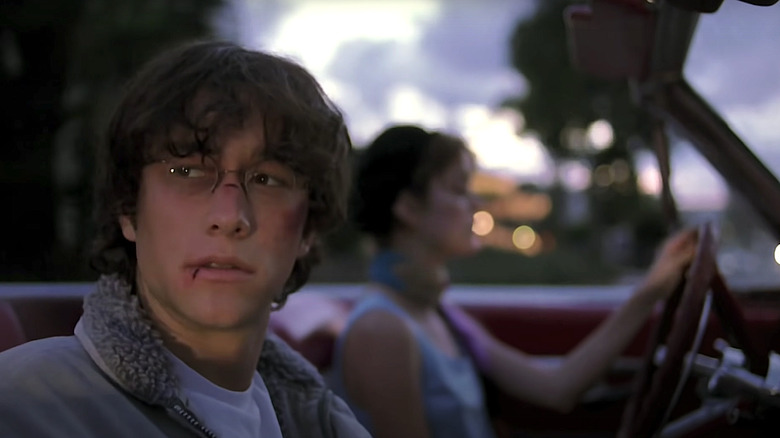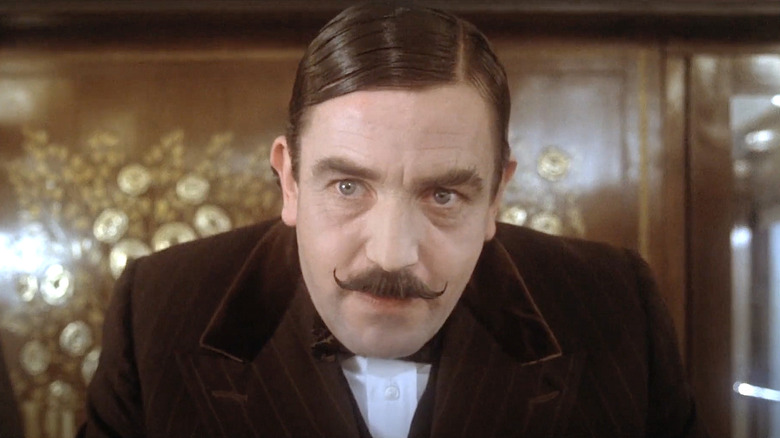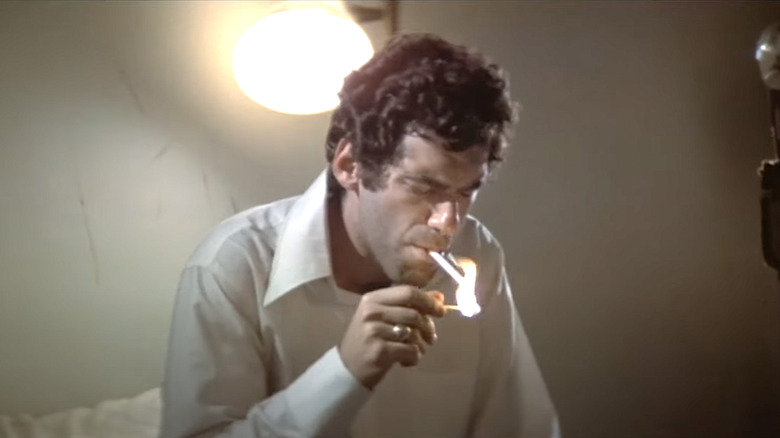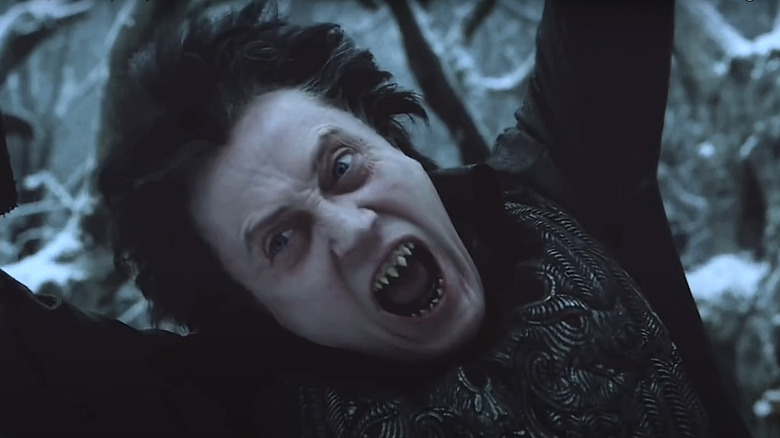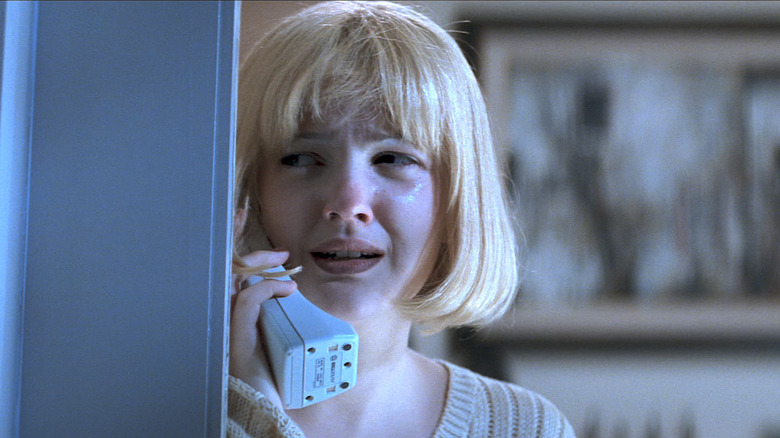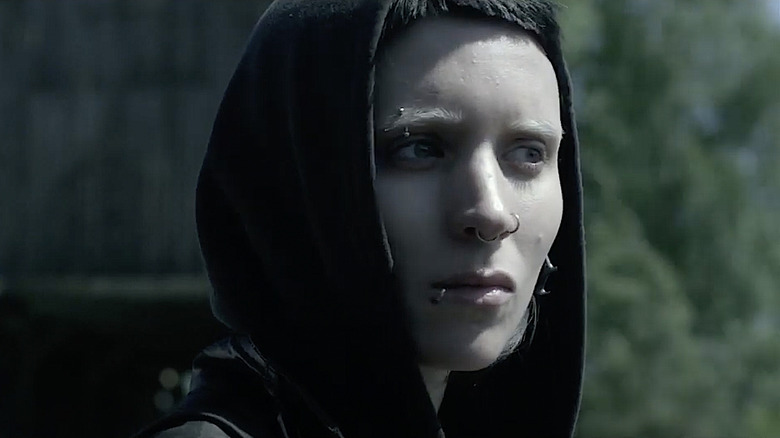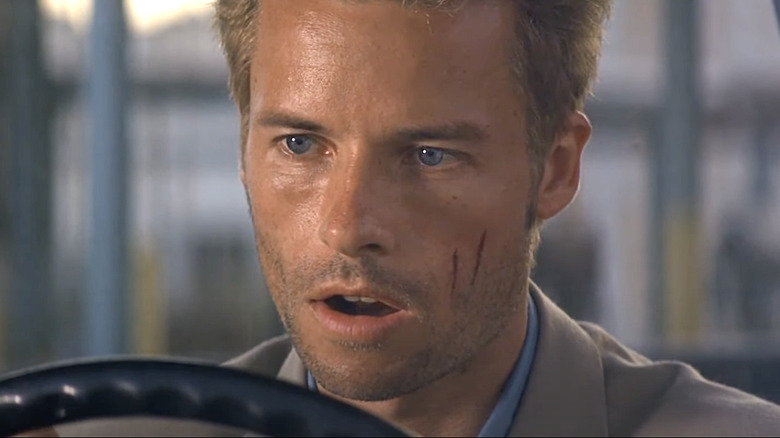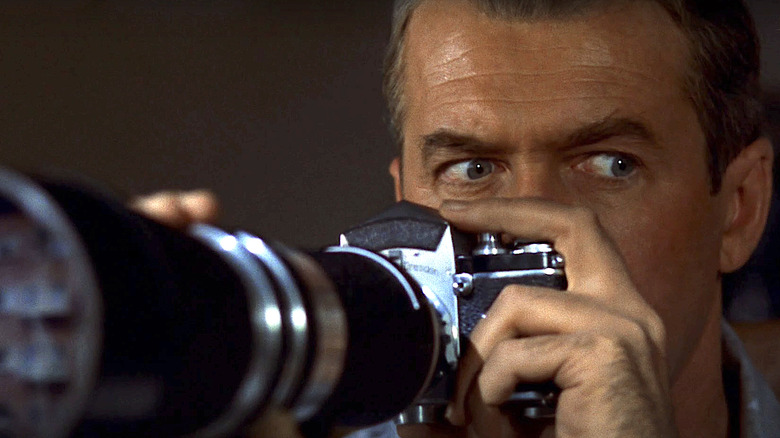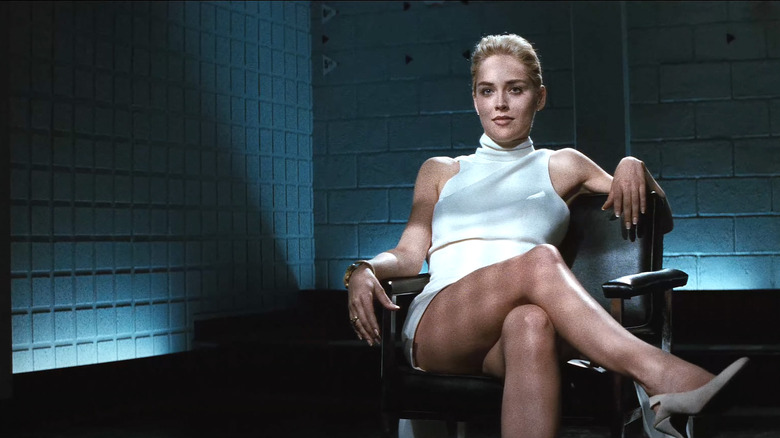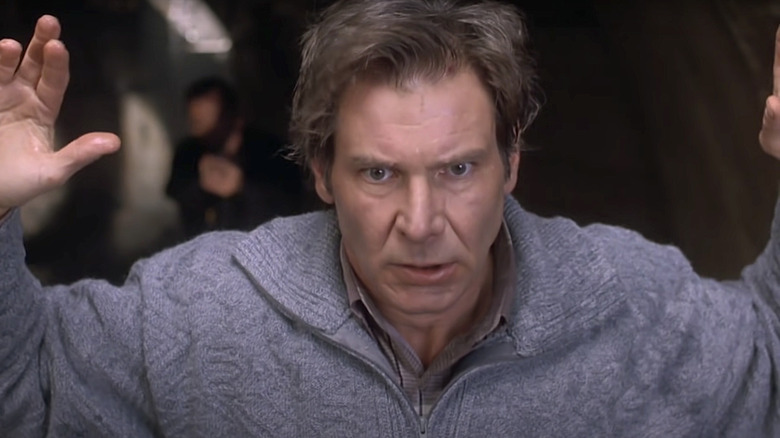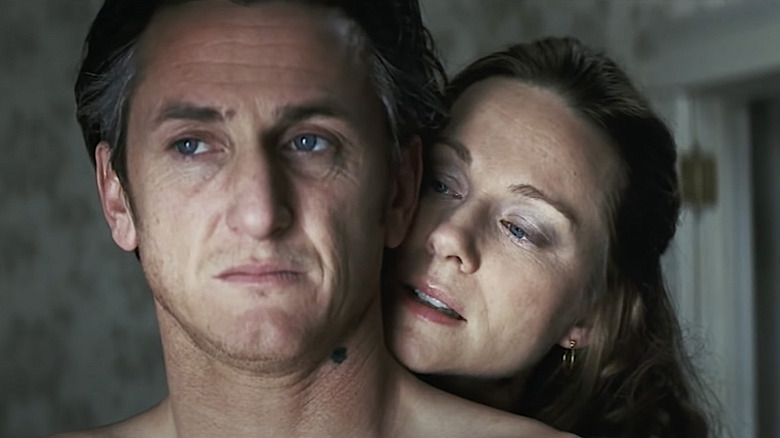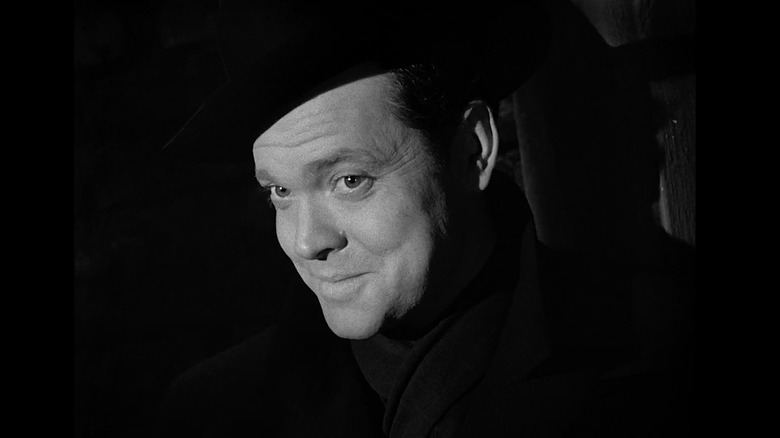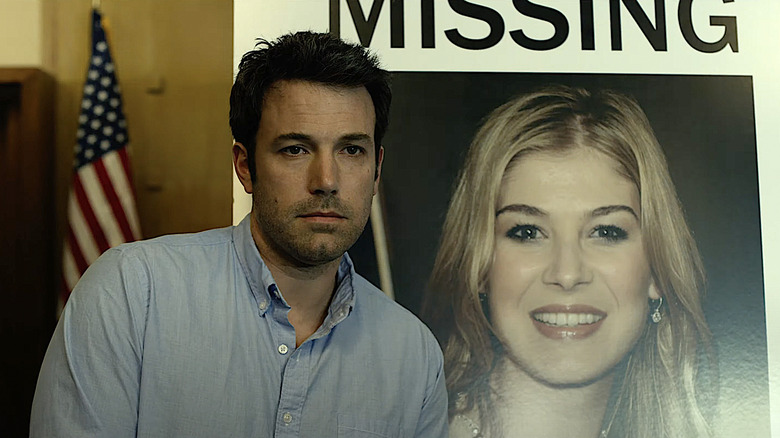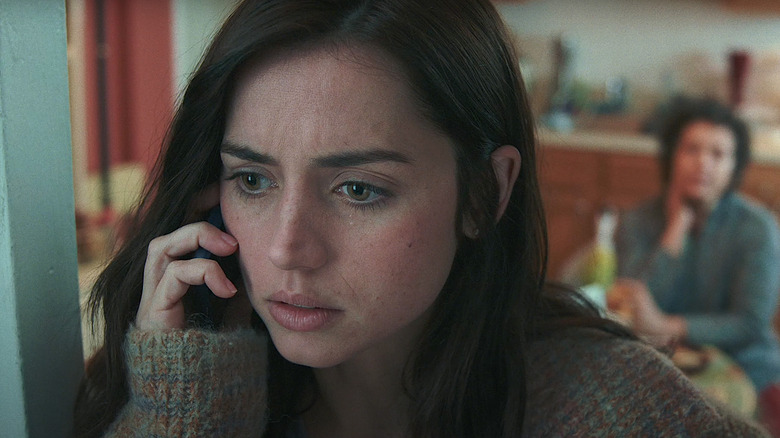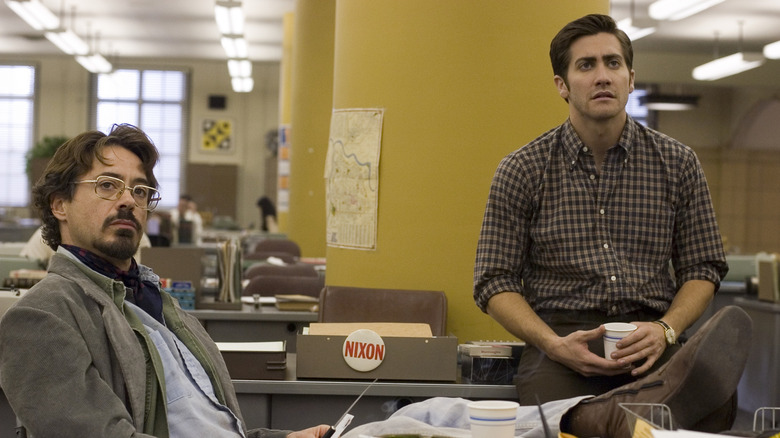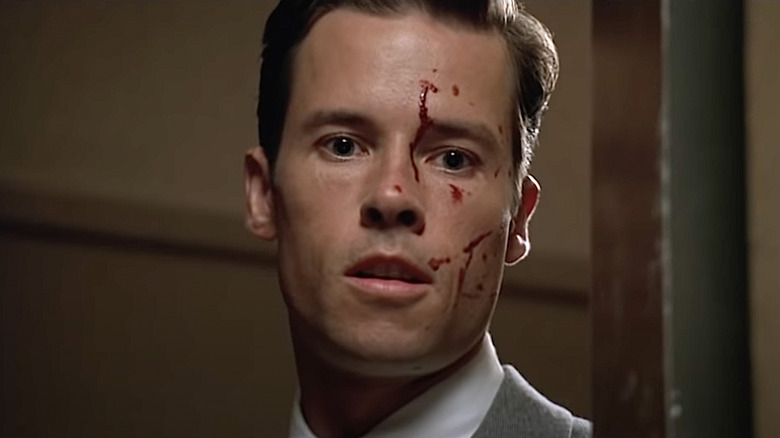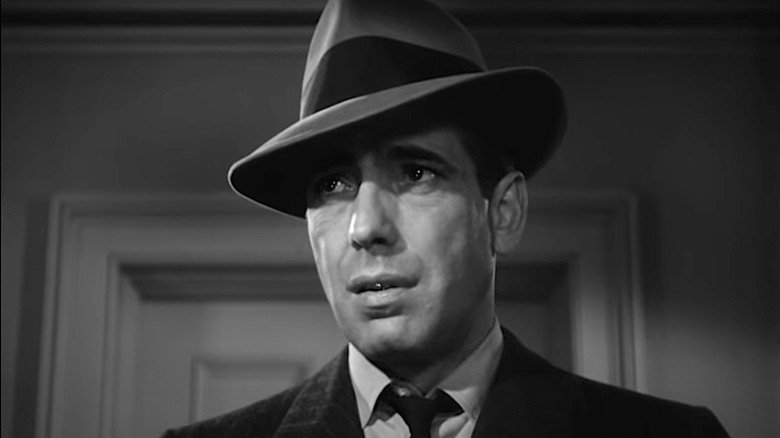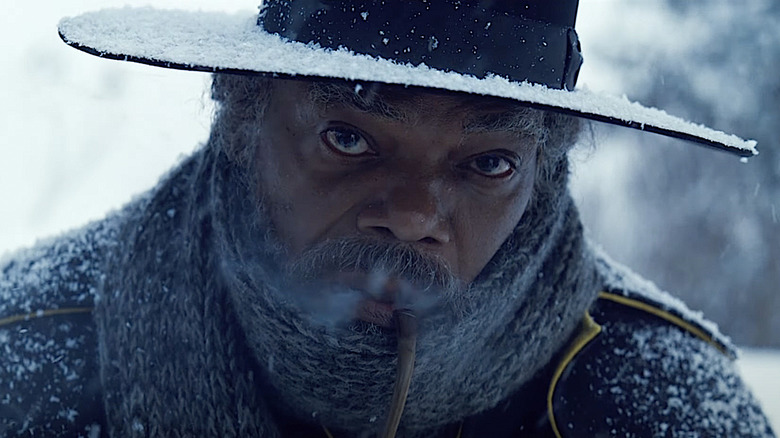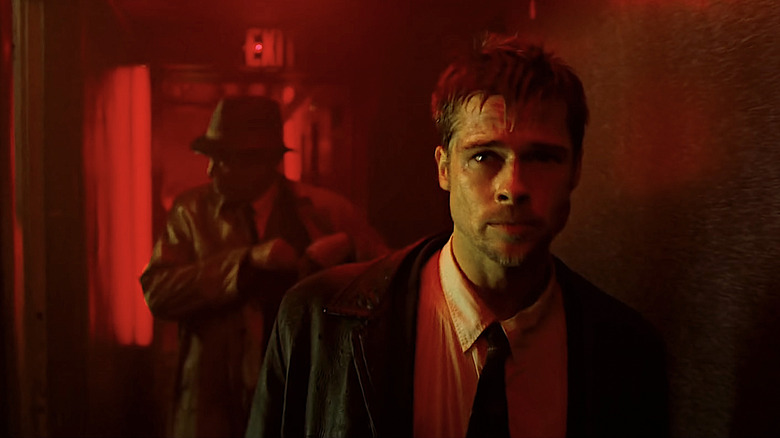The 30 Best Murder Mystery Movies Ever Made Ranked
Alfred Hitchcock had a big influence on the murder mystery genre in the 1930s. His early films like "The 39 Steps" are admirable historically, but a bit too dated at this point to make a straight-faced recommendation. Hitchcock's thriller plots and shadowy sensibilities were followed by '40s films like "The Maltese Falcon" where Hollywood's most rugged mid-century individual, Humphrey Bogart, started solving complex murder plots with his fast-talking devil-may-care flair. Studios were buying up pulpy detective novels and Agatha Christie page-turners, and the genre was coming together.
Decades later films like "Gone Girl" are playing with the form and ensuring the murder mystery movie is as viable as ever. Audiences will always pay to be puzzled, horrified, and even briefly confused, as long as they are thrilled in the end. Murder mysteries pique our desire for forbidden knowledge. We love being tantalized with secrets, scandalized by lurid reveals, and then relieved when the world is put back into semi-working order. Here are the 30 best murder mystery movies ever made, ranked.
30. Identity (2003)
Long live Agatha Christie's influence, the murder mystery queen. "Identity" from 2003 is a loose adaption of the writer's novel "And Then There Were None." It begins with the classic whodunnit gambit: 11 strangers are trapped in a motel during a storm as a killer among them begins picking them off one by one. As this excellent ensemble (including John Cusack, Amanda Peet, Ray Liotta) scrambles to solve the mystery and save their skin, there's a parallel plot about a man on trial for murder. His execution, however, might be stayed on the grounds he's insane. The link between these two plots is not initially clear, but that's the twist ... or at least one of them.
Not everything in this solid potboiler works. In the post-"The Usual Suspects" and "The Sixth Sense" world, Hollywood filmmakers really started scrambling to insert incredible twists. Roger Ebert dubbed this the "Keyser Söze syndrome" and it does feel like aughts movies were stricken with a mismatch between supply and demand for plausible trick endings. "Identity" delivers at least one solid surprise, though. The secondary turn feels like a bit of a cheat, but if you enjoy the locked-room mystery genre, this is a very entertaining lark.
29. Bad Times at the El Royale (2018)
"Bad Times at the El Royale" begins with the premise of a bad joke: A priest (Jeff Bridges), a soul singer (Cynthia Erivo), a traveling salesman (John Hamm), and a cult leader (Chris Hemsworth) converge at a once-hip but largely forgotten hotel on the California/Nevada border. There's also a rogue F.B.I. agent, the secret machinations of J. Edgar Hoover, callbacks to the Vietnam War, and even strong allusions to John. F. Kennedy assassination conspiracies.
"Bad Times at the El Royale" is the creation of writer-director Drew Goddard, who also conceived the 2011 horror deconstruction project "The Cabin In The Woods." This has a similarly playful conceit, but for the neo-noir crime genre with an Agatha Christie "everyone-is-a-suspect" formula. Goddard's story gets absurdly twisty by way of its mystery meta-commentary, packed with as much mid-century detail as the hotel's excellent retro set. "Bad Times" might be overstuffed, but the kitchen-sink sprawl brings lively new energy to an old formula.
28. In a Loney Place (1950)
"In a Lonely Place" from 1950 is Humphrey Bogart's most underrated film. Bogey plays gifted but washed-up Hollywood screenwriter Dixon Steele. He's beyond cynical about the business and life in general but takes a job adapting a trashy novel that doesn't interest him. When he finds out the hat check girl at his local watering hole knows the book, he brings her home so she can tell him the story. It's a seductive ploy, maybe, but when she's soon found dead Dixon becomes the main suspect. Undaunted, he begins an affair with his neighbor (Gloria Grahame) but as his strange and boozy behavior escalates she begins to wonder if the man she loves could really be a killer.
Bogart is playing the same kind of fast-talking, brooding, world-weary tough guy he usually inhabits, but in the context of the murder mystery, this legendary persona becomes downright suspicious. Under the glare of interrogation, his devil-may-care flair reads as glib and downright psychopathic ... at least if he's guilty. This is one of the best uses of the audience's preconceived notions about an actor in any Hollywood film. Bogart never worked with Alfred Hitchcock, but the psychological brinkmanship of this plot is the closest analog from the star's indelible canon.
27. Clue (1985)
Movies based on board games have a challenging history. It's still hard to fathom how "Battleship" from 2012 got a greenlight from Universal Pictures given that the game doesn't have even the semblance of a story. Clue the board game, on the other hand, is a whodunnit like any good Agatha Christie novel. The 1985 adaptation sticks to the deductive premise thanks to solid work by "My Cousin Vinny" director Jonathan Lynn and a nice inciting premise invented by scribe John Landis of Michael Jackson's iconic "Thriller" music video fame.
The ensemble cast is invited to a remote mansion as each has been the victim of a blackmail scheme. Once they arrive they take pseudonyms borrowed from the game (Professor Plum, etc) and are introduced to their extortionist. Each "player" is then given a weapon from the game and asked to kill the blackmailer. That's when the lights go out. When they come back on, the organizer of this devious game is dead, not the blackmailer, and everyone is a suspect. The setup is irresistible and the execution is endearingly tongue-in-cheek. "Clue" retains all of its campy charms and has aged into a real vintage delight.
26. The Nice Guys (2016)
Russell Crowe and Ryan Gosling had a serious bromance during their extensive press tour for this 2016 detective comedy by the legendary "Lethal Weapon" scribe turned director Shane Black. The superstar's onscreen chemistry is definitely this underrated film's main draw. Gosling plays a bumbling Los Angeles private detective in the late 1970s. Crowe is an enforcer type, in the vein of "Ray Donovan" but not nearly as high-end. The duo forms an unlikely team when a young woman (played by the luminous Margaret Qualley) goes missing.
From there "The Nice Guys" is a playful descent into tropes of the Los Angeles crime noir underworld, but clumsier, in the amusing-yet-solidly-plotted vein of Robert Altman's "The Long Goodbye." "The Nice Guys' scratches that murder mystery itch and checks off all the right buddy cop boxes too. Black's script isn't quite as off-beat and amusing as Gosling and Crowe are together in real life, and maybe that's a reminder of why the best American comedies so reliably cast improv masters like Will Ferrell or Jonah Hill. However, the casting of two dramatic movie stars playing it straight — and yet against type — is a very enjoyable novelty. If you can commit to the nearly two-hour runtime, this is a mystery comedy worth investigating yourself.
25. Charade (1963)
Audrey Hepburn was tossed into several awkward May-December romance roles during her iconic career. Her onscreen affair with Humphrey Bogart in "Sabrina" from 1954 is the most uncomfortable to watch. The word from the set was that Hepburn was just 24, while Bogey was 54 and "looked old enough to be Audrey's grandfather," according to the book "Audrey and Bill" (via Mail Online). "Charade" from 1963 has a bit of that dynamic too. Hepburn was 33 while Cary Grant was 59, but even well into his grey hairs Grant cuts a dashing figure, and at this point in Hepburn's career she was no longer an ingenue. She was playing a much more worldly woman coming out of an unhappy marriage, so the romance plot plays better, despite the 25-year age gap.
What really works in "Charade" is the murder mystery. Peter Joshua (Grant) and Regina Lampert (Hepburn) meet cute on a ski trip in the French Alps. They're both coming out of failed marriages, but when they return to Paris, Regina's husband has been murdered. Peter and Regina uncover a motive involving her husband's ill-gotten gains plundered in World War 2, but when Peter's identity comes into question things really get interesting. Grant's fumbling, gentile big-screen persona makes him the perfect movie star to pull off a deception in plain sight. This is a charming and light-hearted murder mystery caper and a must for fans of these two old Hollywood legends.
24. Kiss Kiss Bang Bang (2005)
"Kiss Kiss Bang Bang" is a film noir parody with a genuinely entertaining crime plot of its own. This is the ultimate meta murder mystery for cinephiles who have seen it all. Even the odd title is taken from a 1968 collection of Pauline Kael essays. Kael is undoubtedly the most influential American film critic (at least when it comes to influencing filmmakers), and she gets a loving nod here from those in the know.
Like any good movie about movies, it stars actors playing actors. Robert Downey Jr. is Harry, a small-time crook who goes out for a part in a mystery film. He lands it when he starts confessing to a real crime because the director thinks he's just method acting. When he next links up with an old flame (Michelle Monaghan) and a hard-boiled private investigator (Val Kilmer) the trio come across a dead body and accidentally frame themselves for the murder ... sort of. The plot is a comedy of errors as the three are sucked into a familiar film noir underworld while trying to solve the mystery. This is another caper from legendary Hollywood scribe Shane Black of "Lethal Weapon" fame and his best auteur effort as a writer-director, in the vein of his other noir sendup "The Nice Guys." Downey and Kilmer are fantastic, while Black's story and direction amount to an immensely entertaining love letter to the murder mystery and noir genres.
23. In the Heat of the Night (1967)
If you love detective stories with righteous vindication plots then "In the Heat of the Night" from 1967 remains a thrill. The great Sidney Poitier plays Detective Virgil Tibbs, a black homicide detective from Philadelphia arrested for murder by racist Mississippi police chief Bill Gillespie (Rod Steiger). Tibbs quickly demonstrates his innocence but then reluctantly agrees to help his accuser track down the real killer. The moment the racist cop humbles himself and asks Tibbs to help with this small-town murder investigation is the film's best moment. "Why can't you look at it for yourself!?" Poitier shouts, still justifiably angry at his accuser. "Because I'm not an expert," admits the Gillespie with his tail between his legs.
"In The Heat of The Night" probes the era's color and class lines but puts forward the optimistic notion that the thin blue line comes first. Maybe in real life, Gillespie wouldn't so quickly swallow his pride, but this film is a standout of Hollywood's civil rights era vision for racial reconciliation, and it's beautifully done. Poitier's detective nobly overcomes his outrage partly because he can't help himself. He's a true detective, and solving murder mysteries is what he does. This is a classic about Black excellence and racial healing, built atop a taut procedural that will keep you hooked until the real crook is booked.
22. Gosford Park (2001)
"Gosford Park" is just "Downton Abbey" if someone suddenly assassinated Lord Grantham. This 1991 murder mystery from director Robert Altman and scripted by "Downton Abbey" creator Julian Fellowes was certainly the impetus for that seminal series. It's an upstairs-downstairs dramedy set in an aristocratic English country estate in 1932. It even features Maggie Smith as a snobbish, silver-tongued matriarch, Lady Trentham, whose name even rhymes with her more amusing "Downton Abbey" dame, Lady Grantham. The fantastic ensemble of notable British and American stars descend on a lavish country manor for a long weekend of dining, after-dinner boozing, and shooting at pheasants, but when one of the least-liked elites is murdered everyone is a suspect.
Other notable performances include a young Ryan Phillippe as a randy footman who tries to bed every woman he meets, upstairs and down. Fellowes loves the archetype of the attractive, obsessive servant. Clive Owen broods as another dashing footman with a mysterious past. Bob Balaban is meta perfection as a Hollywood producer coincidentally (perhaps?) researching a film he's making about a murder mystery set in an English country home. Kelly Macdonald is the real star, though, playing an observant ladies' maid who pieces together the tawdry puzzle. "Gosford Park" is a brilliant proto "Downtown Abbey." Fellowes cut out the cynicism in his strikingly similar TV tribute to this bygone era, but otherwise it's a copy-paste premise and an utter delight in both incarnations.
21. Blow-Up (1966)
"Blow-Up" is worth at least skimming if you want a full arsenal of pretentious film school references. Like "The Conversation" (below) this is a murder mystery about the ambiguity of evidence, this time hinging on the reliability of celluloid itself as a simulacrum for real events. This was the first English-language film of Italian director Michelangelo Antonioni, working in the far-less commercial industry of western Europe. Both French and Italian directors at the time were experimenting with form and questioning whether cinema had to be about telling stories at all.
"Blow-Up" feigns a mystery plot when a London fashion photographer thinks he's accidentally taken a picture of a murder. He obsesses over every piece of film grain trying to enhance a gun-like splotch. A femme fatale type eventually shows up and wants the photos. Is she part of the plot? If this were the American imitation "Blow Out" by Brian De Palma in 1981, this woman would eventually be spoon-feeding us a grand explanation. Since it's a mid-century Italian film, "there is no spoon," as that Buddhist kid from "The Matrix" would say.
20. The Conversation (1974)
"The Conversation" is about paranoia and that deep sense that someone is watching ... or in this case, listening. In the conspiracy-minded Watergate era, director Francis Ford Coppola was considering a concept that was definitely in the ether. An unusually reserved Gene Hackman plays surveillance expert Harry Caul, a solemn private eye in the body of a tech whiz who gets hired by a suspicious client to spy on a young couple. Caul gets fixated on one ambiguous recording and soon thinks everyone involved is in danger. This is a "new" Hollywood classic as the industry took an iconoclastic turn in the 1970s towards experimentation. It's essentially an audiophile's version of Alfred Hitchcock's 1954 film "Rear Window" in which Jimmy Stewart thinks he sees a murder, but can't be sure.
Decades after Coppola made the three greatest films of all time back-to-back-to-back with "The Godfather I & II" and "Apocalypse Now" the director is less present in pop culture than his prolific contemporary Martin Scorsese. Coppola's final Godfather film in 1990 was disastrous. His "Bram Stoker's Dracula" in 1992 is so gratuitously pretentious it's an absolute good-bad masterpiece totally worth watching. Before he hit a creative brick wall, Coppola was one of the best filmmakers America ever produced and this is an important work from the legendary auteur's heady prime.
19. Brick (2005)
"Brick" is the early-career brainchild of galaxy-brained Hollywood writer-director Rian Johnson ("Looper," "Knives Out"). This low-budget neo-noir was his first full-length feature in 2007 but showed off the auteur's cinephile bonafides reminiscent of other filmmaking savants like Quentin Tarantino or Martin Scorsese. The joke of "Brick" is that it's a noir murder mystery in the vein of a Humphrey Bogart classic but the entire cast is aughts high school kids riffing like anti-heroes from the black and white 1940s. Nobody nods and winks at the camera. It's all played dead serious even during a crucial scene as a teenage drug kingpin's mother serves cookies and milk.
Joseph Gordon Levitt wants answers when he finds his ex-girlfriend's dead body. As he roves from the jocks to the drama kids, party girls, and burnouts, the complex noir plot snakes through the parallel hierarchies of public school cliques. The great thing about "Brick" is that seeing a bunch of kids acting in the affected style of mid-century noir really puts in relief the genre's tropes. "Brick" is a loving homage to the noir form by a writer-director who has continually added fresh takes to established genres.
18. Murder on the Orient Express (1974)
Films based on novelist Agatha Christie's sensibilities are a small genre unto themselves. "Death on the Nile" kept her actual work alive in 2022. The British scribe is by many estimates the best-selling author of all time. Her work is a bit like "Law and Order," ripped from the headlines and turned into twisty whodunnits. Sidney Lumet's 1974 adaptation of Christie's most famous novel "Murder on the Orient Express" is still the high-water mark for this train-set caper. It starts with a similar scenario to the abduction of the Lindbergh baby. Two years before the 1934 novel, the infant child of world-renown aviator Charles Lindbergh was taken from his home. A ladder was left against the open nursery window, a trail of muddy footprints, and a ransom note demanding $50,000. A dramatic cat-and-mouse negotiation ensued but the child was found dead and a German immigrant was later executed for the crime.
Albert Finney, Ingrid Bergman, Sean Connery, Lauren Bacall, and Anthony Perkins lead a walk-of-fame cast that's hard to beat. There's also a 2017 remake by Kenneth Branagh that received a lukewarm reception. It's perfectly acceptable if you can't get past the blown-out highlights of 1970s film stock. Lumet's original got a solid anamorphic digital restoration in 2017 that looks good but the version most available to stream is a muddy-looking crop to 16x9, a borderline criminal disservice to this historic film.
17. The Long Goodbye (1973)
Elliot Gould plays private eye Phillip Marlowe quipping his way through "The Long Goodbye" in a relaxed counterculture version of the character that influenced Jeff Bridges' burnout detective "The Dude" in "The Big Lebowski." It's a long way from the manic, fast-talking take on Marlowe from Humphrey Bogart in "The Big Sleep" decades earlier. Gould's Marlow has no shadowy office and no svelte secretary. He works from home where he's so busy muttering to himself and doting on his cat that he hardly notices the hippy girls doing yoga outside his window. Director Robert Altman's playful adaptation of Raymond Chandler's pulpy detective novel instantly grabs you by keeping the camera trained on this chilled-out detective. The film doesn't have the stark compositions of classic noirs like "The Third Man," but Altman's roving camera is so sure-handed this 1973 classic could almost be mistaken for a modern film shot on steadicams.
The plot kicks off when an old friend named Terry Lennox shows up at Marlow's door in the middle of the night covered in scratches. Terry admits to a fight with his wife and wants a lift to Mexico. Marlowe is so low-key he agrees but when both Terry and his wife are found dead, a conspiracy plot comes knocking too. Lists like these often recommend old films that play like long novels: They're rewarding if you can get through them. "The Long Kiss Goodbye" is pure murder mystery pleasure credits to credits.
16. Sleepy Hollow (1999)
"Sleepy Hollow" is Tim Burtons' most underrated film and perfectly marries his love of gothic fairy tales and light-hearted humor. This 1999 retelling of Washington Irving's story first published in 1819, takes practical-effect inspiration from British Hammer Studio horror films of the 1950s and 1960s. These films upped the ante from golden-age monster movies with graphic scenes of gore and fancifully colored spurting blood. Burton's vision could come off a little over-the-top if you're not hip to the homage.
Per usual the goth kid auteur casts his pale-skinned muse Johnny Deep to play an unusually handsome but no less comic version of Ichabod Crane. The New York City Detective is called to the small town of Sleepy Hollow to investigate a series of murderers we know too well ends in the appearance of a headless apparition, played by Christopher Walken. The broad strokes of this story date at least as far back as the 14th-century poem "Sir Gawain and The Green Knight," which also got an excellent adaptation in 2021. There is no better filmmaker to combine American folklore and mid-century monster movie sensibilities than Burton at the '90s peak of his powers.
15. Scream (1996)
When "Scream" came out in 1996 Hollywood had already been churning out suburban slasher flicks like "Halloween" for 20 years. "Scream" director Wes Craven had personally taken the genre into a more supernatural realm with the "A Nightmare on Elm Street" franchise in the 1980s. "Scream" screenwriter Kevin Williamson's whodunit script is most notable for its ironic and self-aware meta-commentary. It's a brand of movie humor steeped in pop cultural references that probably peaked with "Juno" in 2007. The style transforms reckless teens into wise-cracking cultural sages who never run out of pithy rejoinders.
Jamie Kennedy is the movie's resident horror movie expert and his succinct summary of slasher tropes is meta-cinematic nirvana. This ironic guide to survival includes: avoiding procreation, avoiding drugs, alcohol, and, "never, ever say 'I'll be right back,' because you won't be right back." Of course, this knowingness is also hubris that gets these kids killed as a mysterious masked murderer cuts through half the excellent cast. The carnage includes Drew Barrymore playing a sacrificial lamb slaughtered in the first scene. It's an ode to films like "Psycho" where a movie star is butchered in the opening act for shock value. "Scream" is a thrilling aural history of slasher flicks tucked cleverly inside an actual slasher film and it's no surprise the sequels continue to pile up.
14. The Girl With The Dragon Tattoo (2011)
This might as well be a list of David Fincher films as cinema's master of neo-noir thrillers did it again in 2011 with "The Girl With The Dragon Tattoo." Some have argued the original 2009 Swedish adaptation of Stieg Larsson's novel felt more true to the story's Scandinavian roots, but there's no better craftsman than Fincher and if he remakes your movie, you probably have the second-best film. Larrson died of a heart attack at age 50. Like his main character and obvious avatar Mikael Blomkvist, Larsson was a middle-aged magazine founder dead-set on taking down right-wing extremists. So when he died suddenly right before his books became global sensations, conspiracies about shadowy forces swirled. The New York Times had a more grounded theory. The writer may have caffeinated himself to death:
"Larsson's is a dark, nearly humorless world, where everyone works fervidly into the night and swills tons of coffee; hardly a page goes by without someone 'switching on the coffee machine.'"
All this is an intriguing footnote to Fincher's cyberpunk thriller about Blomkvist partnering with hacker Lisbeth Salander to solve a cold case murder. The pulsing rhythms of Fincher's adaptation include Karen O's plaintiff wales on an otherwise industrial score by frequent Fincher collaborator Trent Reznor. This remake is a pure shot of espresso for the tired murder mystery genre and admittedly has more zip than the excellent original adaptation.
13. Memento (2000)
In 2000 Christopher Nolan's stunning breakout "Memento" announced the arrival of a filmmaking savant with a knack for reviving every Hollywood genre he touched. Just as "Inception" reimagined action and "Dunkirk" re-thought the World War II genre, "Memento" turns mystery filmmaking on its head. Not only is the identity of the killer an open question, but the hero's own mind is a riddle wrapped in one of the most inventive puzzle plots ever put to celluloid. A young Guy Pearce plays Leonard, a man who loses the ability to make new memories after taking a blow to the head while witnessing the murder of his wife. He's determined to track down her killer, but with no short-term memory, every clue he collects must constantly be rediscovered and questioned.
Nolan and his scribe brother Jonathan are masters of high-concept screenplays which often focus on the peculiarities of time. Jonathan penned the short story called "Memento Mori" on which the film is based. It's a Latin phrase meaning, "remember, you are mortal." Victorious generals in ancient Republican Rome would designate a slave to whisper this incantation into their ears during the ecstatic heights of ritual Roman military parades. As Leonard seeks vengeance on his wife's killer, we discover he may already have gotten his pound of flesh, but how could he know for sure? Living with no memory is like living outside time as Leonard's tragic earth-bound immortality becomes a permission slip for evil.
12. Rear Window (1954)
"Rear Window" is Alfred Hitchcock's 1954 ode to his own voyeurism. The iconic director was well known for his fixation on his leading ladies, but the rotund Brit allegedly hated his own appearance and was relegated to admiring women from afar. A 2016 Hitchcock biography (via Daily Mail) claimed the director had a marriage that wasn't especially intimate and was "obsessed" with the personal lives of the blonde stars he worked with like this film's second lead, Grace Kelly.
"Rear Window" is among the most Freudian films ever made. Hitchcock cast Jimmy Stewart as the stand-in for himself named Jeff, a photographer trapped inside his sweltering New York apartment after breaking his leg on assignment. As he convalesces from a wheelchair, Jeff becomes obsessed with spying on the neighbors in his building's elaborate courtyard. Sometimes he even pulls out long camera lenses to get a better look at a golden-haired dancer he's dubbed "Miss Torso." When Jeff thinks he's witnessed a murder, this peeping-tom detective needs more proof before the supposed killer turns his attention on this immobile witness. Hitchcock allegedly felt he was deformed. He lived a guilt-fueled life of repression peppered with the twisted fantasies he put onscreen. Jeff is Hitchcock's impotent voyeur. He's physically limited, and spends his days trapped in fantasy that combines fantasy and murder.
11. Basic Instinct (1992)
"Basic Instinct" is mostly remembered for Sharon Stone's eye-popping turn as a twisted man-eater who squirms out of a police interrogation with a strategic uncrossing of her legs. Yet the film is more than the sum of its racy memes. Exhibit 1: the lurid script sold for a record $3 million in 1990, according to screenwriter Joe Eszterhas. Amazingly, he told the AV Club he penned it in only 13 days. This 1992 neo-noir thriller helmed by gonzo king Paul Verhoven ("Robocop," "Total Recall") uses explicit material to elevate the femme fatale into a physically formidable rival. Stone's clever crime novelist Catherine Tramell is suspected of dispatching her rockstar boyfriend in a brutal slaying. When police detective Nick Curran (Michael Douglas) gets tasked with the investigation, he immediately finds Tramell a person of interest ... and that's exactly how she wants it.
"Basic Instinct" has some of the most graphic scenes in R-rated cinema history, and like the comparably subtle Alfred Hitchcock classic "Vertigo" the more this cop becomes taken with his subject the more he's pulled into her vortex. Even as Catherine seduces Nick, his conviction that she's a killer only adds to the forbidden passion of their unhealthy connection. "Basic Instinct" borders on the pornographic, but always in service of a riveting thriller plot. In other words, it's a Hitchcock film if he'd lived to work in the anything-goes early '90s.
10. The Fugitive (1993)
It's not often Hollywood treats us to a murder mystery with blockbuster visuals starring one of the industry's biggest stars at the peak of their powers, but that's what we got from underrated director Andrew Davis (the man behind excellent '90s thriller "A Perfect Murder") with "The Fugitive." Based on the original TV series from 1963, Harrison Ford plays respected doctor Richard Kimble. When his wife is brutally murdered during a home invasion he takes the rap but escapes during a prison transport gone wrong. Once on the lamb, Kimble must find a mysterious one-armed man he thinks killed his wife before a federal marshal played by Oscar-winner Tommy Lee Jones (at his crotchety best) can haul him in.
"The Fugitive" is, unfortunately, the kind of movie that doesn't get made anymore: a mid-budget mystery for adults. There are no superpowers, no world-ending MacGuffins. The most challenging scene to film was certainly the train crashing into Kimble's prison bus, for which Warner Bros. wrecked an actual choo-choo in 1993. This incredible stunt is both unimaginable today and probably unnecessary considering CG capabilities. "The Fugitive" holds up, but also, no one has really bothered to top it.
9. Mystic River (2003)
"Mystic River" isn't Clint Eastwood's best film — that's obviously "Unforgiven" — but it is the legendary actor/director's most studio-polished piece of work. Eastwood is known for capturing scenes in one take and moving on. It's an actor-friendly style that made him prolific even into his '90s. It's also created some unevenness in his canon (see "Cry Macho" for details). "Mystic River" is an Oscar-winning film where the auteur's craft really flows. The story follows three Boston-area friends in the 1970s riven by trauma when one is abducted and abused. Decades later, the men have gone their separate ways. Tim Robbins plays the victim grown-up, brooding in the shadow of this horror. Sean Penn matures into a small-time gangster and loyal family man, but when his daughter is murdered the third in his old trio (Kevin Bacon) is named lead detective, and the other (Robbins) becomes the prime suspect.
Like all great mystery films, the killer must be hidden in plain sight. Maybe the trauma these men suffered has created a monster, but which of them is it, really? "Mystic River" is in the mode of Greek tragedy, dressed up in 20th-century garb. Like Oedipus, it's about the inescapability of destiny. These men living on the working-class shores of Boston's actual Mystic River can make peace with the flow of time, or not. That's up to them. The tides of fate are coming in either way.
8. The Third Man (1949)
In "The Third Man," paperback western writer Holly Martin (Joseph Cotton) arrives in Vienna to stay with a friend named Harry Lime (Orson Welles) only to find he's been killed. Lime's mysterious girlfriend seems to know more than she says, and so does everyone else. What unfolds is a story of corruption rooted in the black markets of post-war Europe. Director Carol Reed's mystery noir is often considered the best British film of all time. Its lighthearted style and elegant mise-en-scene clearly inspired the oeuvre of Wes Anderson, Steven Soderbergh, and the early crime capers of Guy Richie, but it does have one amusing flaw. It somewhat overuses the off-kilter framing of the Dutch angle, a noir trope meant to signify mysterious happenings, but there's no psychological logic behind the technique. Some shots are crooked. Some aren't. After the film debuted, fellow director William Wyler sent Reed a spirit level with a note attached: "Carol, next time you make a picture, just put this on top of the camera, will you?" notes Indiewire.
This style choice accents one of the most beautiful films ever shot in high-contrast black and white. The streets of Vienna shimmer, particularly at night, with great beams of backlight flooding the cobblestone boulevards and casting long shadows on the ruins of this historic city in murky decline. Reed worked so tirelessly achieving the film's glorious aesthetic he developed an addiction to Dexedrine to keep up with his 20-hour a day shooting schedule.
7. Gone Girl (2014)
"Gone Girl" points out that we social animals wear our identities like costumes. We all play different roles with parents or siblings or lovers. The dynamics can be so different it raises real questions about the self. The story drills down on the unsustainable lie of our romantic courtship personas, and how that charade can mean some spouses only truly meet long after they tie the knot. Ben Affleck and Rosamund Pike play a seemingly idyllic suburban couple, Nick and Amy Dunne. Nick is a handsome dilettante and Amy is a spoiled-but-thwarted overachiever, embittered about playing the "cool girl" for too long as she puts up with Nick's aimlessness. They gave up their big-city life for stability, but when Amy vanishes a trail of clues points to the dark cracks in this marriage.
This is another neo-noir by David Fincher, the undisputed modern master of the genre. The filmmaker's exacting visuals are a stark contrast to the messy sprawl of this twisty and blood-spattered revenge thriller. It's hardly a spoiler to say more is going on than a missing person's case. "Gone Girl' borders on a black comedy about keeping things going for appearance's sake. It asks a question that can haunt any intimate relationship: Can you ever truly know someone else's mind? If not, what evils is your spouse actually capable of?
6. Knives Out (2019)
"Knives Out" is one of the most delicious murder mysteries ever thanks to the savant-stylings of writer-director Rian Johnson of "Looper" and "Brick" fame. Johnson applies his wry meta-cinematic wit to a whodunnit in the style of "Clue." The radiant Ana de Armas plays a nursemaid for a wealthy novelist (Christopher plumber). When the great man dies under suspicious circumstances his good-for-nothing family starts circling like vultures. That's when Daniel Craig doing a Foghorn Leghorn southern drawl as Detective Blanc shows up to put the whole clan under his magnifying glass.
While penning the airtight script that cuts deep into this bourgeois family's dysfunction, Johnson was on a mission to prove himself. He'd heard the feedback from the extreme online community who hated his "Star Wars: The Last Jedi." The director wanted to make "Knives Out" engage with "the current state of online culture," he told Deadline in 2019. Every modern filmmaker telling a contemporary story has to decide if the ubiquitous smartphone will be a part of their film. Johnson wanted this Agatha Christie-inspired story to be very much of its time, so the phones, as well as the knives, are out in the screenplay he populates with characters "who for better or worse you could only meet in 2019."
5. Zodiac (2007)
"Zodiac" might be the greatest murder mystery of all time about an unsolved case. We usually love the genre for its proverbial page-turning tension en route to an "ah-ha" catharsis, but director David Fincher's 2007 film is up to something very different. The killer who haunted the San Francisco area of the late 1960s and early '70s was never caught, so a rock-solid resolution can't be the payoff. Fincher still crafts a methodical whodunit with an eerie parade of suspects. Jake Gyllenhaal plays the real San Francisco Chronicle cartoonist Robert Graysmith, who gets obsessed with the case when the killer begins sending coded clues to the newspaper where he works. Graysmith is slowly undone by this unsolvable riddle.
In 2021 a cold case team plausibly claimed to have finally cracked the long-mysterious Zodiac ciphers and identified a supposed rural gang leader, Gary Francis Poste, as the killer. Poste died in 2018, so perhaps again eluded justice, but his name turned out to be the code's key. The question was the answer. Poste probably enjoyed this logician's joke, as an encrypted version of his name was printed in every major newspaper. "Zodiac" makes no mention of this latest real-world suspect but it doesn't matter. The killer's twisted infinite jest is the point.
4. L.A. Confidential (1997)
"L.A. Confidential" is a neo-noir in the style of "Chinatown" that delves into all the dimly-lit decadence of mid-century Los Angeles, but it stands above many noirs for telling a compelling murder mystery to boot. Many of the best classic detective noirs like "The Third Man" or "The Big Sleep" have plenty to recommend but sag somewhat with episodic story structures where one clue leads to another in a long black-and-white blur of dames and names, until the 90-minute mark when somebody finally spills.
"Confidential" has the virtue of encasing both the deeper anti-hero themes of classic noirs while telling a taut detective tale that keeps you anchored to the plot. Guy Pearce heads the stellar cast as Exley, the son of a murdered detective who discovers the city's corruption may have killed his old man. Kevin Spacey plays a showboat cop and symbol of the city's circular grift. He feeds gossip to tabloids, consults for TV shows, and cares mostly about getting his name in the city's dishonest rags. Russell Crowe represents the old school, a brutal enforcer cop with a hair-trigger temper. His simmering conscience makes him Exley's only plausible ally to clean up a corrupt cop shop and root out the devils in the city of angels.
3. The Maltese Falcon (1941)
"The Maltese Falcon" is the murder mystery that basically invented film noir. Cinematographer Arthur Edeson thought a dark tale should be shot in a visually dark style to match, and borrowed from German expressionism to create this shadowy 1941 masterpiece. Before this film, big Hollywood films often used lighting schemes closer to TV sitcoms where almost everything is evenly illuminated. Noir brought purposely crafted contrast to cinema, a stark style that also more accurately reflects the real world, suffused in both shadow and moral ambiguity.
Humphrey Bogart plays private eye Sam Spade in John Huston's adaptation of Dashiell Hammett's pulpy detective novel. The plot sets a paradigm for the genre when a beautiful dame shows up at Spade's office asking for help finding her sister, but when Spade's partner is murdered Bogey's iconic detective is thrust into a mystery that involves the hunt for the film's titular treasure. Noir murder mysteries almost always envelop the hero under false pretenses, often in the form of a femme fatale. These alluring ladies are symbols of a romantic chase that is sure to end in disaster. They represent desire, not just for their beauty, but because they hold a weary secret. They're simultaneously in distress, but also a trap waiting to spring. As Bogey is pulled down the rabbit hole, Hollywood's biggest golden-age movie star chews every scene as he cuts the mold of conflicted American anti-heroes for decades to come.
2. The Hateful Eight (2015)
"The Hateful Eight" is mostly a dinner party whodunnit, like any game of "Clue." Kurt Russell plays the boisterous "hangman" bounty hunter John Ruth with a wanted fugitive chained to his arm. They're caught in a blizzard when they come across another bounty hunter played by Samuel L. Jackson. The group holes up at Minnie's Haberdashery, a rickety mountain cabin filled with suspicious characters. The only problem is Minnie is missing, and the man running her roadside rest stop doesn't seem too trustworthy. As the group waits out the storm, someone poisons the coffee and writer-director Quentin Tarantino has Jackson's character puzzling through the multiple murder plots.
Tarantinos' fantastic eighth film is a lot more like a stage play than anything else he's ever done, and in fact, he's been threatening to retire from filmmaking and become a playwright. He might feel burned by Hollywood after the first draft of his "The Hateful Eight" script was leaked by a Gawker-affiliated website. Tarantino had only given the pages to three actors and it's amusing how the film mirrors this now-famous whodunnit as Tarantino examined his own inner circle for treachery. The final script certainly punishes the villain as Channing Tatum makes a memorable cameo in the hilarious and bloody finale. The best version of this film is the extended, episodic cut via Netflix. Somehow the interludes turn this very long film into an even longer series you will want to binge in one sitting.
1. Se7en (1995)
"Se7en" is a riveting procedural about the hunt for a biblically inspired serial killer who, even once caught, remains a mystery. David Fincher's 1995 masterpiece has had countless imitators ("Kiss The Girls," "The Bone Collector," "The Little Things") but none hold a candle. Denzel Washington was originally up for the Brad Pitt role but turned it down because he thought screenwriter Andrew Kevin Walker's gothic masterpiece of a script was too "dark and evil ... Then, when I saw the movie, I was like, 'Oh, shoot,'" Washington told Entertainment Weekly in 2010.
Washington's loss was a young Brad Pitt's gain. Working with David Fincher was pivotal for the star, as the two would go on to collaborate on "The Curious Case of Benjamin Button" and "Fight Club." Pitt has assiduously avoided playing generic heroes, and "Se7en" marks a proof of concept for that position. In 2004 he got cajoled by Warner Bros. to play Achilles in the entertaining-but-cheesy "Troy." He swore by the gods he'd never do that again. "I'm following my gut from here on out," he said of his disappointment with the finished film. Pitt hated all the generic hero shots, the lack of an auteur's specificity. "I'd become spoiled working with David Fincher," he understandably explained. Decades later, the duo's grisly murder mystery remains the pinnacle of both iconic artists' mighty careers.
